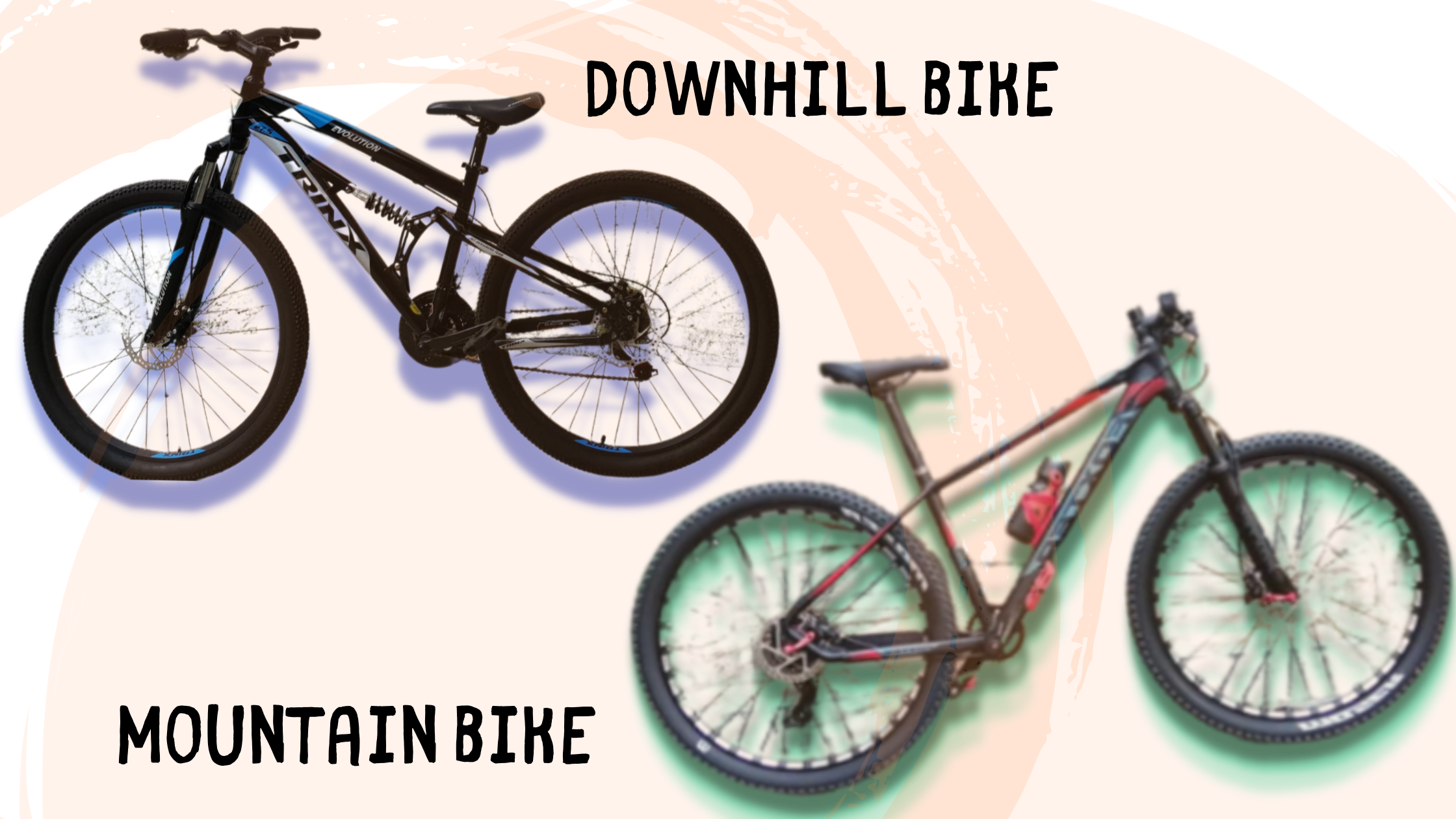Today, cycling as a hobby has gained more popularity with its benefits for people’s health and its positive contributions to the environment. While this may start out as a hobby, a lot of people have come to develop their interest in cycling and have started to invest in the best gear out there. Since there are a lot of choices, you may be one of the people wondering which bike to get, more specifically, whether you should get a downhill bike or a mountain bike.
What is the difference between a downhill bike and a mountain bike? A downhill bike is made for steeper trails that require your equipment to be sturdier. On the other hand, a mountain bike is more versatile and can be used for both uphill and downhill trails.
In this article, we will be talking about the main things you need to know about a downhill bike. On top of that, we will tackle several areas where a downhill bike differs from a mountain bike. Definitely, this discussion will allow you to see which option best fits your needs and which bike will be worth your money. To get to the bottom of the downhill vs mountain bike discussion, continue reading.
All the Need to Know About Your Downhill Bike and Mountain Bike

Before we can begin to compare a downhill bike with a mountain bike, we have to touch on the topic of the basic parts of a bike first to set a common point of reference. Don’t worry, this section won’t be too technical. This simple discussion primarily serves the purpose of allowing you to understand the next parts of this article that will tackle your main question.
Parts of a Bike
Frame
This is basically the largest part of your bike. Called the “backbone” of your gear, the frame is where everything is connected. What’s important to note about the frame is that different types of materials can be used to manufacture it. This is because different materials target different needs and preferences both downhill and mountain bikers may have.
That said, aluminum and carbon frames are the common choices, but price-wise, carbon frames usually cost more.
Wheels
Just like the frame, a bike’s wheelset is a part that has many alternatives to choose from. Choosing the right wheelset among such alternatives is crucial because it directly affects the speed and weight of your bike. More importantly, the lightness of your wheels determines how much more your downhill and mountain bikes can speed up.
Simply said, the right wheelset will improve the overall performance of your gear by providing the strength and durability that fit your needs.
Pedals and Cranks
As you may already be familiar with, pedals and cranks are the parts that you push to get your bikes moving. This doesn’t have to be too complicated; all you have to remember is that there are two different kinds of pedals for downhill bikes and mountain bikes. A flat pedal is usually used by beginners while a clip pedal is used by cyclists who want more pedaling power.
Chains and Gears
These parts are also considered to be one of the most important parts of your bike simply because they are connected to your pedaling power. To illustrate, think of how one shift gear could make a whole difference to the speed and control of your downhill or mountain bike. That’s how significant it is.
Brakes
The short summary that would explain this part would be that a bike’s (1) handlebar brake levers are connected to the (2) brake pads by the (3) brake cables. Basically, all these three components work together to create an effective brake system for both downhill and mountain bikes. As for the types of brakes you can choose from, it is said that disc brakes are suitable for all types of mountain biking as it offers consistent braking regardless of various conditions.
Other Parts
Of course, for both types of bikes, there is the handlebar that controls the direction of the rider. The seat post and the saddle are, as the name suggests, essential for the biker’s comfort. It is recommended that this be wet proof to be suitable for any weather conditions.
Factors to Consider Before Buying a Downhill Bike and Mountain Bike

Now that you know the main parts of a downhill and mountain bike, let’s delve into the specifics of the bikes you want to learn about. In this section, we will be tackling the main areas where a downhill bike and a mountain bike differ.
Builds of the bikes
Suspension
A downhill bike is made for steep and fast trails. Consequently, it relies on full suspension to absorb the greatest impacts without making the biker feel uncomfortable. Thus, when looking for downhill bikes, it is recommended for the buyer to look at the quality of the fork and rear shock which should have a suspension featuring rebound, as well as compression and preload settings.
For a mountain bike, preference for suspension depends on where you’ll use your bike most of the time. If you’ll mostly use the bike on dirt or fire roads, or smooth singletrack, consider getting a hardtail. However, if you expect to use the bike mostly just for singletrack, you might want to go for full suspension.
Wheel Size Difference
With downhill bikes, smaller wheel circumference is more common unlike the 29-inch wheels usually recommended for mountain bikes. This is because the smaller the rims, the more structural rigidity there is. Such is especially needed when going downhill fast. It is worth noting, however, that the wheel circumference may not be the best factor in decision making as both bikes offer counterparts that feature the same measurements when it comes to that.
The difference is downhill bikes are made to withstand plowing through rough surfaces on a very steep trail. This then requires them to be thicker and generally heavier in material. In connection with going through a downhill trail, it is also recommended to choose wheels that have 32-36 spokes as this prevents you from having to struggle with the handlebar.
For regular mountain bikes, 29-inch wheels help as you’ll run through rocks and carry more speed for a longer time. You may also get carbon wheels if you prefer a lighter, stiffer, and more responsive wheel which also saves energy. But, as mentioned, this will probably cost more.
Frame
Downhill bikes are designed to allow more “relaxed geometries.” This basically explains why they have longer wheelbases that make people feel as if they are “in” the bike instead of “on” it. As you can expect, this build is made to make the riders feel as comfortable as they can when going over rocky terrain. Thus, bikers are positioned lower in downhill bikes as compared to mountain bikes.
The Pros and Cons of a Downhill Bike and a Mountain Bike
The Pros and Cons of a Downhill Bike
Let’s talk about the pros first. First of all, downhill bikes are built for acceleration and speed whilst maintaining better stability and easier control. They are mostly made from strong materials like aluminum alloy or steel and are designed to be heavier for added sturdiness. Next, they have fewer gears, so you can get a second-hand downhill bike and fix it on your own.
For the cons, maintaining a downhill bike will likely hurt your pocket. Even if you have affordable options for getting this bike, maintaining it is where all your money will go. Definitely, this baby needs a lot of your tender love and care for proper upkeep.
More importantly, choosing a downhill bike means that you’ll also have to take advantage of its proper use. Thus, you may need to constantly travel to trails that may be far from where you live. These bikes are not meant for flat and concrete surfaces so you have to expect that before riding, you will have to allot time for transportation.
The Pros and Cons of a Mountain Bike
The evident pros of a mountain bike are that they require less effort to ride and it is generally easier to get one. On top of its affordability, there is a wide variety of options available so you can find one that is suitable to your liking. Its big con, however, is that it is more difficult to control it when going downhill. More than that, affordable mountain bikes tend to be of low quality.
Related to the mountain bike, you might have heard of its cousin, the enduro bike which is basically a trail bike but with more suspension. Therefore, they can be used for both uphill and downhill trails but with more control as compared to an average mountain bike. This is why it is called the “jack of all trades” of bikes. The con, still, is that because of its versatility, it is not better than the specifically designed downhill bike for downhill trails.
The Cost of a Downhill and Mountain Bike
Lastly, you might want to talk about the cost. Downhill bikes and mountain bikes, as you may already know, are not cheap. If you want to get the best of the best, these bikes will usually cost you around $12,000 while the lowest price you can score is around $194 (although the quality is not guaranteed).
When talking about average bikes of these types, the cost usually ranges between $3,000 and $4,000. As these do not come cheap, it is very important to do your research and determine what bike fits your needs. It is then helpful to learn about the materials used and the quality of a bike to properly compare all your choices. This way, you’ll make the most out of your purchase.
Conclusion
All in all, choosing between a downhill bike and a mountain bike depends on the need you have for your gear. If you are a downhill trail enthusiast then, it is obvious that the downhill bike would be the better investment for you. Even if they come with cons like their weight and less maneuverability because of their frame, downhill bikes are the recommended option if you’re planning on going fast down a steep trail. To end, it helps to reflect on what you need and if a versatile option is what you’re looking for, you may be better off with a mountain bike or an enduro bike.


